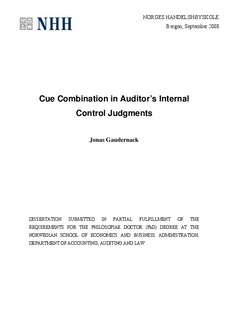Cue combination in auditor's internal control judgments
Doctoral thesis
Permanent lenke
http://hdl.handle.net/11250/162371Utgivelsesdato
2008Metadata
Vis full innførselSamlinger
Sammendrag
A key issue in audit judgment research has been how auditors combine information cues in order to make judgments. Prior research has shown that appropriate forms of cue combination can be identified by analyzing task characteristics, and that many auditors combine cues in a manner appropriate to the interrelationship of cues in the judgment task. Furthermore, appropriate cue combination has been found to be important for judgment quality. However, evidence on cue combination in auditor’s internal control judgments is mixed and from the pre-1990’s. Prior findings may therefore be outdated and incomplete compared to the task characteristics auditors’ face, and the behaviour they exhibit, when making internal control judgments in the current audit environment.
Content and Contribution of the study:
The study identifies five appropriate forms of cue combination in internal control judgments as a function of five forms of control interrelationships and two forms of judgment response scale. A policy capturing experiment is then conducted. Findings indicate that auditors generally make internal control judgments by combining cues in a predictable and appropriate manner, given the variation in control interrelationships and the judgment response scale. The main contribution of the study is to extend normative theory and descriptive evidence on how auditors should, and do, respond to changes in judgment task characteristics (i.e., control interrelationships and the judgment response scale) by changing the functional form of their judgment policy (i.e., how they combine cues). This knowledge is important for audit practice, since task analysis can help auditors make better judgments and thereby perform better audits.
